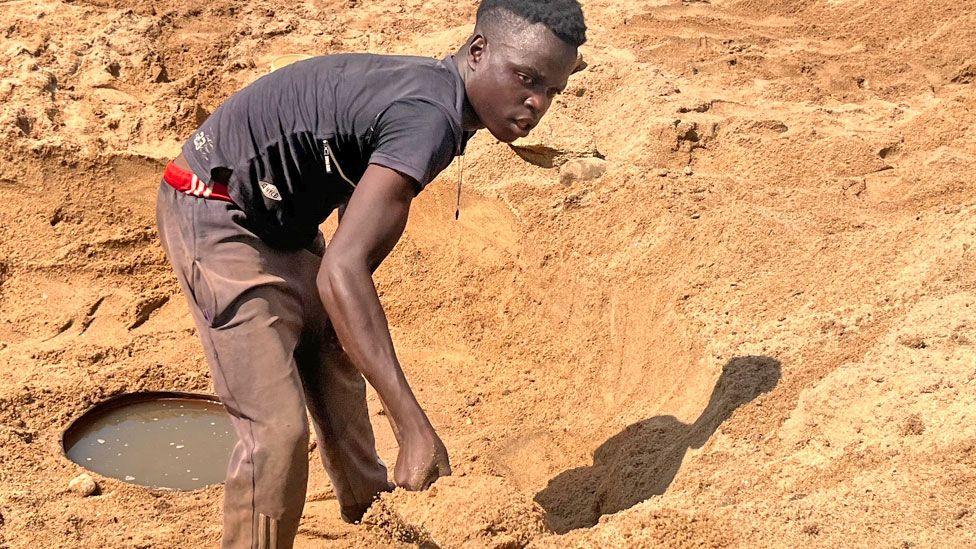One of the worst droughts in history is ravaging southern Africa, leaving nearly 70 million people without adequate food and water.
In the Mudzi district of northern Zimbabwe, a community and their cattle are gathered on a bone-dry riverbed. The Vombozi normally flows all year round, but right now it is just beige sand as far as the eye can see.
Armed with shovels and buckets, the men dig into the riverbed, desperately trying to extract the last drops of water.
In other parts of the district, rivers and dams have dried up and as a result, more and more people are moving to this particular riverbed in Kurima village, putting pressure on the water source.
There are several holes along the riverbed, large enough for one bucket.
Children wash themselves, women do laundry and water their lowing cattle.
Gracious Phiri, a mother of five, stands among these women. The 43-year-old tells the BBC that she now has to walk further than usual, spending three hours each day collecting water.
Mrs Phiri lowers her bucket into the half-metre (19-inch) wide hole and draws out brown water. She worries that her family will get sick.
“As you can see, the cows drink from the same well as we do. Their urine is there… it’s not very healthy,” she says.
“I’ve never seen anything like this.”
Food shortages are also rife in Zimbabwe, where 7.7 million people are hungry. In Mudzi, the number of families with access to sufficient affordable, nutritious food has fallen by more than half compared to previous years, according to the local health authority.
Children have been hit particularly hard: since June, the number of hospital admissions of young people with moderate to severe malnutrition has doubled.
A village feeding program is trying to address the problem. Once a week, women in the community come together and bring whatever they have to make a porridge for children under five.
Ground baobab fruits, peanut butter, milk and leafy greens are stirred into the porridge to add extra nutrients.
But the list of ingredients is getting shorter every week: for example, brown beans and beans have recently become unavailable due to the poor harvest.
The government, with support from partners such as the UN Children’s Fund, UNICEF, set up the village food program, which ran at least three times a week.
“But because of the El Niño drought, we now only give it once a week,” explains Kudzai Madamombe, Mudzi District Medical Officer.
“Because the rains didn’t come, we suffered a 100% loss of the harvest,” he adds, adding that the program may have to be halted altogether in the coming month as food supplies dwindle.
Clinics that provide Zimbabweans in Mudzi with essential health care have also been hit, with boreholes supplying water to a quarter of the district’s clinics having dried up, Mr Madamombe said.
And the largest dam in the district only has enough water for a month.
As a result, vegetable irrigation programs, including one that supported 200 local farmers, have been suspended.
The misery is everywhere. Tambudzai Mahachi, 36, says she has planted acres of maize, cow-peas and peanuts on her plot.
For all her hard work she got nothing, not even a plate of food. Even her strong baobab tree hardly produced any fruit.
Normally, in a good year, Mahachi would supply markets in the capital Harare, but now she is one of millions of Zimbabweans who rely on donations.
While the village feeding program only provides food one day a week, her children need to eat every day.
Sitting in a thatched hut, she cooks wheat to feed her two children breakfast, provided by a charitable neighbor.
“We’ve gone from eating what we want, when we want, to restricting meals,” says Ms. Mahachi.
“The older girl understands that sometimes we can only eat porridge. But sometimes I see that my youngest is hungry.”
Rainfall has failed to materialise in most of southern Africa this year, with agriculture on the continent largely dependent on rainfall rather than irrigation for water supply.
The drought has led to about a third of countries in southern Africa declaring a state of emergency, leaving a whopping 68 million people in the region in need of food aid.
The Southern African Development Community (Sadc) – a grouping of countries in the region – appealed for $5.5bn (£4bn) in aid to combat the effects of the drought in May. So far, only a small share has been received.
“If you go anywhere in southern Africa, you will see that the granaries are empty and that maize, which is the most consumed carbohydrate in the region, has now become unaffordable for many people,” Tomson Phiri, spokesperson for the World Food Programme (WFP) for southern Africa, told the BBC.
“The situation will only get worse.”
The WFP has received only a fifth of the $400 million it needs in emergency aid, he says, adding that southern Africa is facing its worst maize shortage in 15 years.
And the hunger and water crises have yet to reach a peak: October, the hottest and driest month of the year, is still a long way off.
If it rains in November or December (normally the rainy season begins), farmers have to wait until March to harvest maize.
Mrs. Mahachi is well aware of this as she breaks open some wild fruits to satisfy her hunger, unsure of what the coming months will bring for her family.
You may also be interested in:
Go to BBCAfrica.com for more news from the African continent.
Follow us on Twitter @BBCAfricaon Facebook on BBC Africa or on Instagram at bbcafrica
BBC Africa Podcasts

